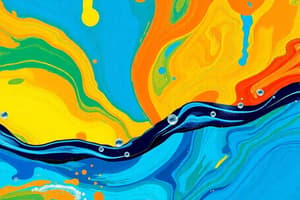Podcast
Questions and Answers
What percentage of the Earth's surface is covered by water?
What percentage of the Earth's surface is covered by water?
- 80%
- 70% (correct)
- 50%
- 60%
Only 1% of the Earth's water is directly accessible for consumption.
Only 1% of the Earth's water is directly accessible for consumption.
True (A)
Name two factors that influence water consumption.
Name two factors that influence water consumption.
Population and climate.
The total amount of water available, including direct and indirect use, is known as the __________.
The total amount of water available, including direct and indirect use, is known as the __________.
Match the following factors to their descriptions regarding water consumption:
Match the following factors to their descriptions regarding water consumption:
Which of the following is NOT a risk associated with water supply challenges in Belgium?
Which of the following is NOT a risk associated with water supply challenges in Belgium?
Heavy rainfall is a potential cause of waterlogging in Belgium.
Heavy rainfall is a potential cause of waterlogging in Belgium.
What is one impact of prolonged dry periods on agriculture?
What is one impact of prolonged dry periods on agriculture?
The investigation into soil and groundwater primarily occurs in ________ regions.
The investigation into soil and groundwater primarily occurs in ________ regions.
Match the following challenges with their consequences:
Match the following challenges with their consequences:
What is the primary focus of the instrument being discussed?
What is the primary focus of the instrument being discussed?
The instrument is used to study the effects of climate change on air temperature.
The instrument is used to study the effects of climate change on air temperature.
What does 'bodemdegradatie' refer to?
What does 'bodemdegradatie' refer to?
What is primarily responsible for the increase in global temperatures?
What is primarily responsible for the increase in global temperatures?
The term 'verlording' is likely related to __________.
The term 'verlording' is likely related to __________.
Match each observation with its description:
Match each observation with its description:
Higher population density has no correlation with higher temperatures.
Higher population density has no correlation with higher temperatures.
Name one significant effect of climate change on sea levels.
Name one significant effect of climate change on sea levels.
The __________ of permafrost leads to disturbances of microorganisms and plant life.
The __________ of permafrost leads to disturbances of microorganisms and plant life.
Match the climate change effects with their descriptions:
Match the climate change effects with their descriptions:
Which component is responsible for the solid part of Earth?
Which component is responsible for the solid part of Earth?
The hydrosphere includes all forms of water on Earth, such as rain, rivers, and oceans.
The hydrosphere includes all forms of water on Earth, such as rain, rivers, and oceans.
What is the primary role of the atmosphere in relation to Earth's temperature?
What is the primary role of the atmosphere in relation to Earth's temperature?
The process of water vapor condensing to form rain occurs in the __________.
The process of water vapor condensing to form rain occurs in the __________.
Match the following components to their functions:
Match the following components to their functions:
Which of the following components is NOT part of the earth's system as discussed in the notes?
Which of the following components is NOT part of the earth's system as discussed in the notes?
Extra atmospheric gases contribute to the cooling of the atmosphere.
Extra atmospheric gases contribute to the cooling of the atmosphere.
What is the primary cause of warming in the atmosphere?
What is the primary cause of warming in the atmosphere?
The balance between inbound radiation and outgoing radiation is known as the ______.
The balance between inbound radiation and outgoing radiation is known as the ______.
Match the following key terms with their definitions:
Match the following key terms with their definitions:
Which of the following statements provides a cause for an increase in atmospheric temperature?
Which of the following statements provides a cause for an increase in atmospheric temperature?
The notes conclude that calculated values regarding the greenhouse effect are consistent.
The notes conclude that calculated values regarding the greenhouse effect are consistent.
What is likely indicated by the questions 'a) Is it true?' and 'b) Is it false?' in the conclusions section?
What is likely indicated by the questions 'a) Is it true?' and 'b) Is it false?' in the conclusions section?
Flashcards
Dry Days
Dry Days
Days with less rainfall than expected for a specific period.
Prolonged Dry Periods
Prolonged Dry Periods
Extended periods of time with little or no rainfall, lasting longer than normal.
Waterlogging
Waterlogging
The soil becoming saturated with water, making it difficult for plants to grow.
Heavy Rainfall
Heavy Rainfall
Signup and view all the flashcards
Sea Level Monitoring
Sea Level Monitoring
Signup and view all the flashcards
Greenhouse Gas Emissions
Greenhouse Gas Emissions
Signup and view all the flashcards
Albedo Change
Albedo Change
Signup and view all the flashcards
Permafrost Thaw
Permafrost Thaw
Signup and view all the flashcards
Plant Migration
Plant Migration
Signup and view all the flashcards
Species Migration
Species Migration
Signup and view all the flashcards
Water on Earth
Water on Earth
Signup and view all the flashcards
Water Consumption Basics
Water Consumption Basics
Signup and view all the flashcards
Water Consumption Comparison
Water Consumption Comparison
Signup and view all the flashcards
Water Balance
Water Balance
Signup and view all the flashcards
Direct vs. Indirect Water Use
Direct vs. Indirect Water Use
Signup and view all the flashcards
Climate Change Impact
Climate Change Impact
Signup and view all the flashcards
Groundwater Depletion
Groundwater Depletion
Signup and view all the flashcards
Soil Degradation
Soil Degradation
Signup and view all the flashcards
Soil Erosion
Soil Erosion
Signup and view all the flashcards
Preventing Water Infiltration
Preventing Water Infiltration
Signup and view all the flashcards
Biosphere
Biosphere
Signup and view all the flashcards
Atmosphere
Atmosphere
Signup and view all the flashcards
Hydrosphere
Hydrosphere
Signup and view all the flashcards
Geosphere
Geosphere
Signup and view all the flashcards
Greenhouse Effect
Greenhouse Effect
Signup and view all the flashcards
Inbound Radiation
Inbound Radiation
Signup and view all the flashcards
Outgoing Radiation
Outgoing Radiation
Signup and view all the flashcards
Radiation Balance
Radiation Balance
Signup and view all the flashcards





